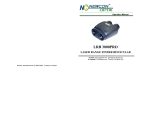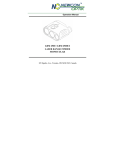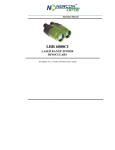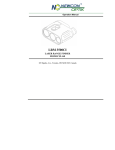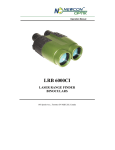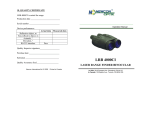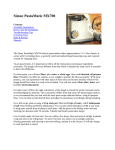Download Newcon Optik LRB 3000PRO Binoculars User Manual
Transcript
Operation Manual LRB 3000PRO LASER RANGE FINDER BINOCULARS 105 Sparks Ave., Toronto, ON M2H 2S5, Canada ii IMPORTANT INFORMATION Read prior to activation You have just purchased a sophisticated electro-optical device that emits invisible laser radiation. To operate it properly, please, read this manual carefully. • NEVER direct laser beam at the eyes of people or animals • NEVER aim the unit at the Sun or bright sources of light • NEVER subject the unit to impacts • NEVER transport the unit without its case • NEVER disassemble the unit. This may be hazardous for you due to high voltage currents • ALWAYS keep the unit out of the reach of children • ALWAYS remove the battery when the device is not in use for a long period • ALWAYS store the unit in a dry place • Caution - use of controls or adjustments, or performance of procedures other than those specified herein may result in hazardous radiation exposure • Caution - use of optical instruments such as binoculars, loupes, mirrors, lenses, etc. with this product increases eye hazard • Avoid eye exposure to direct laser beam or its close reflection • Prevent bright light from focusing through the eyepieces iii • Never aim the unit at highly reflective objects like mirrors and retroreflective surfaces, which are in close proximity to the laser rangefinder. This can lead to the permanent damage of the photoreceiver incorporated into the device. iv TABLE OF CONTENTS 1. BRIEF DESCRIPTION.......................................2 Principle of operation..................................................2 Key Features ...............................................................3 2. DEVICE APPEARANCE ...................................4 3. DELIVERY SET.................................................7 Standard delivery set...................................................7 Optional accessories....................................................7 4. SPECIFICATIONS .............................................7 5. OPERATION INSTRUCTIONS ........................9 Preparing device for operation. ...................................9 Measurement procedure............................................10 Factors affecting measuring distance ........................11 Target selection logic ................................................11 Individual Measurement and Scanning regimes .......12 Operation and service modes ....................................13 Accuracy correction ..................................................15 Compass calibration..................................................16 Data Recall mode......................................................17 6. BEST MEASURING TECHNIQUE.................18 7. STORAGE AND MAINTENANCE.................19 8. TROUBLESHOOTING ....................................20 9. WARRANTY....................................................21 10. CUSTOMER SUPPORT...................................22 11. QUALITY CERTIFICATE...............................23 1 CAREFULLY READ ALL THE INSTRUCTIONS BEFORE USING! FAILURE TO OBEY THE INSTRUCTIONS WILL VOID THE WARRANTY! 1. BRIEF DESCRIPTION The LRB 3000PRO Laser Rangefinder Binoculars (System) is an advanced laser range finder that enables instant distance, speed, and angular measurements. The unit complies with CFR 21, Part 1040.10 and Part 1040.11. An outstanding fully multi-coated optics coupled with an original circuitry design creates a system that outperforms any other product in its class and price range. Principle of operation The unit sends invisible, eye safe laser beam pulses to the target. The pulses reflected from the target are captured and processed by the digital circuitry. The time-of-flight delay between the sent and received pulses allows calculating the distance to the target. A built-in digital compass measures azimuth simultaneously with ranging. 2 Key Features Modern digital circuitry allows targeting through most types of glass Speed detector Selection of the first, last or the most reflective target Distance is displayed in meters or yards Original digital circuitry allows ranging through most types of glass, bushes and other obstacles Three channel optical solution (optical, laser and receiver) provides high accuracy Two reticle shapes: -¦- or Built-in digital compass On-board memory keeps results of last 10 measurements, that can be recalled to the LCD The unit automatically turns off when no button is pressed for 8 seconds 3 2. DEVICE APPEARANCE 4 5 3 1 6 2 Fig. 1. Front view 1 – Eyepieces 3 – Mode button 5 – Battery compartment cover 4 2 – Objective lens 4 – Action button 6 – Rubber grip 1 7 8 Fig. 2. Rear view 1 – Eyepieces; 7 – Interpupillary distance adjustment lever; 8 – Identification and certification label (located at the bottom): 5 5 1 7 6 2 4 3 Fig. 3 Display 1 – Low battery indicator 2 – Reticle (either -¦- or ) 3 – Units of measurement 4 – Measurement result 5 – Laser active indicator 6 – Ready mode indicator 7 – Setup mode indicator 6 3. DELIVERY SET Standard delivery set LRB is supplied in the following assembly: LRB 3000PRO Carrying case Neck strap Operation manual 9V non-magnetic Lithium battery Warranty card Qty 1 1 1 1 1 1 Optional accessories Hard case 4. SPECIFICATIONS Optics Magnification Objective lens diameter Exit pupil diameter Field of view Type of coating 7x 40 mm 5.7 mm 6° Fully multi-coated optics 7 Range Finder Class 1, eye safe, 905 nm Laser 10 – 3,000 m Measuring range Accuracy ±1m First, last and auto target selection Yes Meters/Yards display Yes Last 10 readings recall Yes Reticle -¦- or Speed measurement Measured speed range 5 – 400 km/h / 3-250 mph Accuracy, km/h or mph ±2 Compass Measured azimuth range 360° Accuracy ±2° Power Battery 9V Lithium (nonmagnetic) Min 5,000 measurements (Scanning regime) Yes Battery capacity 'Low Battery' indicator 8 Environmental Operational temperature range Storage temperature range Mechanics Tripod thread Weight without battery Dimensions -25 / +50oC (-13 / +122oF) -45 / +65oC (-49 / +149oF) ¼” x 20 TPI 970 g 158x145x70 mm 5. OPERATION INSTRUCTIONS Preparing device for operation. Rotate the battery compartment cover (5, Fig. 1) counter clockwise and pull it open - Connect and insert battery into the battery compartment. - Close the battery compartment cover (5, Fig. 1). - Adjust the interpupillary distance with lever (7, Fig. 2). - Adjust the eye relief distance by moving collapsing eyepieces (1, Fig. 1) in lengthwise direction. The unit is fully operational when battery voltage is over 6.3V. A ‘LOW BATTERY’ warning is displayed voltage falls below 6.5V. The unit may be powered with 9V batteries capable to sustain 350 mA current drain: • Standard 9V battery may be used as a short term solution. It will last for about 30-45 minutes of continuous operation. 9 - • A 9V Lithium non-magnetic battery guarantees over 5,000 shots at room temperature. It is recommended for the field usage. In addition, this battery does not influence the internal compass. Note: Metal housing of the battery may degrade the compass accuracy. Measurement procedure The LRB 3000PRO operational procedures are design to allow the user to use most applicable options in the fastest time possible. To activate it, press and hold Action button (6, Fig.1) for one second. At start the unit comes into Ready to Measure mode indicated by the word ‘READY’ on the display visible through the eyepiece. Pressing Action button (6, Fig. 1) again will initiate measurement procedure. The results of measurement are displayed in default form of Distance (M) and Azimuth (mils) measurement parameters, which also can be modified to user preference (see Operation and service modes). If results of measurement are unreliable four dashes (‘----‘) will be displayed in the area (4, Fig. 3). Pressing Mode button (3, Fig. 1) gives the user the options to change settings from Factory default to specific modes required by user. For full list of Mode options please refer to Operation and Service modes 10 Factors affecting measuring distance Though maximum measurement distance depends on target reflectivity, weather conditions and other conditions, for most targets the unit will provide accurate ranging for up to 2,500 meters. Under good conditions a large size target can be measured up to 3,000 meters. Target reflectivity depends on its color, surface finish, size, shape, position in relation to the laser beam, etc. Bright target colors are more reflective than darks. A polished surface is more reflective than a rough one. Larger targets reflect better than small ones. Ranging a target perpendicular to the laser beam provides better results than the one positioned at a sharp angle to the beam. Weather conditions that influence air transparency (rain, fog, snow, mist) reduce maximum range. Bright sunny days will reduce performance as well as IR sun radiation may cover reflected laser impulses. While the unit will measure through many glass types, measuring through glass may reduce accuracy. Natural hand tremor decreases the accuracy of long distance ranging. Using of a tripod is highly recommended. Note: device may produce false readings when reticle is aimed at the sun or in ± 20˚ solid angle from the sun. Target selection logic On its way towards the target laser beam may reflect from various objects, thus decreasing ranging accuracy. The 11 smaller, the farther, and the less reflective is the target – the higher is the possibility of obtaining an incorrect measurement. To improve accuracy the unit has a built-in target selection logic that allows choosing which target to range: the nearest (‘first’), the farthest (‘last’), or the most reflective (‘auto’). This mechanism helps selecting the target when ranging from behind the bushes, wires, through the falling snow, or in similar conditions. Similarly it enables ranging a target in front of a bigger object, such as a wire in front of the wall. Note: Even with target selection logic the unit may not always be able to range the desired target as its reflectivity may be too low to produce enough laser beam reflections for statistically reliable calculation. Individual Measurement and Scanning regimes The unit can operate in two regimes: (1) Individual Measurement and (2) Scanning. In the Individual Measurement regime the unit performs single measurement when the A button is pressed shortly, in Scanning regime the unit repeatedly measures and displays results every second while the A button is pressed. To activate the Scanning regime press and hold the A button in the Ready mode. The unit will work in the Scanning regime while the A button is pressed. The Scanning or Individual Measurement regimes are available for any selected mode of measurement. When two 12 parameters are measured in the Scanning regime though both will be quickly displayed, the second one may be difficult to register by eye. Nevertheless all data is recorded and may be recalled (see Data Recall mode for details.) Operation and service modes Pressing Mode button (3, Fig.1) in Ready mode switches the unit between modes of operation, to activate any desired mode from the menu you must confirm your selection by pressing Action button (4, Fig.1) The unit has the following modes of operation: Ready – Unit is ready to perform measurements dFLt – sets default mode of operation with factory settings, Std – allows the user to select single action measurements: o Distance only o Compass Only o Speed Only o Speed + Distance o Distance +Compass Unit – allows user to select units of measurements, o Distance from M to Y 13 o Compass from Mils to Degrees o Speed from KMH to MPH** rEc – allows data recall of the last 10 measurement results, o CLr – Clears all Measurement SEt – allows the user to select the following advanced options: o FrSt – First Target Measurement o LASt – Last Target Measurement o AUtO – Last Target Measurement* o Reticule – Change reticule from + (cross) to (rectangle) o CAL – Calibration and correction ▪ CALc – compass calibration ▪ Corr – accuracy correction of active measurement parameters. * not shown in the menu if currently selected ** this option is only available if Std Speed is selected 14 Accuracy correction If the System produces some measurement errors that lie beyond unit specification, it may be an indication that unit requires calibration similar to one conducted at production level. To do accuracy correction, please select Corr from CAL menu. Perform correction according to required measurement parameters by pressing Action button, see table below: Active mode of measurement (Std) Correction parameter Condition Install unit at 1 meter1 from flat target2 Put unit in a level plane Azimuth and aim it to the North C direction3 Install unit at 1 meter1 from flat target2 Distance and controlling its level dC azimuth position and direction to the North 1 – Accuracy of correction will depend on accuracy of installation against target. If distance is 0.9 meters, then unit will have 0.1 m offset during all future measurements. S, Sd, d Distance 15 2 – Target should not have high-reflective surface (white color is not considered high reflective in this case. 3 – Unit shall be well leveled with deviation from 0 not more than ±0.75 degrees. Horizontal direction shall be to Magnetic North (not True North). If devices detects large installation errors (unit is not well leveled or not aimed to the North), then LCD will show result “444”, which means that correction was not performed due to incorrect setup. Compass calibration If the System was exposed to a strong magnetic field or was not in use for a long time, the compass accuracy may diminish. To return the compass into working condition: Select CALc from CAL menu Keeping the unit horizontally, perform one full rotation (360˚) around vertical axis within a minute If one rotation does not restore calibration – perform two rotations per a minute. The normal compass functioning will be restored. 16 Data Recall mode In Data Recall mode results of the last 10 measurements can be displayed. Measurement results are saved in on-board memory in sets depending on the parameters set for measuring, for instance, if only distance is measured - the set will consist of one number, if distance and azimuth are measured – the set will consist of two numbers. To enter Data Recall mode select rEc from main menu. First measurement set number (display name: rEc 1) will start flashing. Pressing M button moves the unit along the list of measurement set numbers and measurement results: rEc 1, distance 1, azimuth 1, rEc 2, distance 2, azimuth 2, rEc 0, distance 0, azimuth 0. Measurement sets are numbered in reverse order: first recalled set is the result of the last measurement. If any parameter has not been actually measured it will not be recalled. Pressing A button at any moment within the list of recalled results brings the unit to Ready to Measure mode. Choosing cLr at the end of recalled data will erase the device memory. 17 6. BEST MEASURING TECHNIQUE Laser range finder measures distance by catching laser beam reflected from the target. Everything that improves reflection increases the measurement reliability and maximum range. 1. Use tripod when ranging remote targets. The longer is the distance, the greater is the beam shift due to hand tremor. 2. Aim the unit at a surface on the target that is the closest to perpendicular to the laser beam. The better perpendicular to the target – the stronger will be the reflection. 3. The unit deploys sophisticated software that tries to understand which target you are aiming at. However, due to beam divergence several objects may produce a strong reflection. To help the System recognise the target the Target Selection Logic may be used. For example, if ranging a wire in front of a building, selecting the “first” target will produce a more reliable result. Alternatively, when aiming at a chimney behind the trees, selecting “last” target will be better. By default the System assumes “auto” target selection, i.e. the object producing the most of reflections will be considered a target. 18 7. STORAGE AND MAINTENANCE The unit is a sophisticated precision optical instrument equipped with laser and electronics. Therefore, it should be handled with due care. • Keep it away from direct sunlight. • Avoid impacts, jolts, dust, moisture, and sharp changes of temperature. • Do not use the device at temperatures higher than 50oC (122oF). • Do not touch optical surfaces. Doing so may damage the anti-reflection coating. • Clean optical surfaces only with professional camera lens cleaning supplies. • Clean the exterior of the unit with a soft clean cloth. • Keep away from heating appliances and central heating. • Remove the battery when storing the device for long time. • All repair works must be performed by an authorized service. • Prevent bright light from focusing through the eyepiece. 19 8. TROUBLESHOOTING Ranging does not work. The display is transparent. Check the charge of the battery. Replace it if it is weak. Ranging does not work. The display indicates results of the last measurement. Wait until display becomes transparent, and press the Action button again. Compass readings are equal to zero at any direction. Wait until display becomes transparent, and press the Action button again. If this does not help, perform the compass calibration. Black dots are visible on LCD Liquid Crystal Display may have small black dots, scratches and other blemishes inherited from the manufacturing process. These flaws are strictly regulated by number, area and location and do not degrade the product's measurement capabilities. Range measurement cannot be obtained. • Make sure that neither your hand nor finger is blocking objective lens, laser emitting lens or receiver lens. • Hold the unit firmly (avoid hand tremor) while pressing the Action button. • Check that the target is within measuring range of the device and the gating mode does not cut it off. 20 9. WARRANTY NEWCON warrants this product against defects in material and workmanship for one year from the date of the original purchase. Longer warranty is available, subject to the terms of the specific sales contract. Should your Newcon product prove to be defective during this period, please deliver the product securely packaged in its original container or an equivalent, along with the proof of the original purchase date to your Newcon Dealer. Newcon will repair (or at its option replace with the same or comparable model), the product or part thereof, which, on inspection by Newcon, is found to be defective in materials or workmanship. What This Warranty Does Not Cover: NEWCON is not responsible for warranty service should the product fail as a result of improper maintenance, misuse, abuse, improper installation, neglect, damage caused by disasters such as fire, flooding, lightning, improper power supply, or service other than by a NEWCON Authorized Service. Postage, insurance, and shipping costs incurred while presenting your NEWCON product for warranty service are your responsibility. If shipping from North America please include a cheque or money order payable to NEWCON OPTIK for the amount of US$15.00 to cover handling and return shipping. 21 10. CUSTOMER SUPPORT Should you experience any difficulties with your NEWCON OPTIK product, consult the enclosed manual. If the problem remains unresolved, contact our customer support department at (416) 663-6963 or toll free at 1-877-368-6666. Our operating hours are 9am-5pm, Monday - Friday, Eastern Standard Time. At no time should equipment be sent back to Newcon without following the instructions of our technical support department. NEWCON OPTIK accepts no responsibility for unauthorized returns. To locate NEWCON Authorized Dealer call: Tel: (416) 663-6963 Fax: (416) 663-9065 Email: newconsales@newcon-optik.com Web: www.newcon-optik.com The defective products should be shipped to: US customers: 2331 Superior Ave. Cleveland, OH 44114 From all other countries: 105 Sparks Ave., Toronto, ON M2H 2S5, CANADA 22 11. QUALITY CERTIFICATE Serial number _____________________________ The unit has passed the quality inspection. Production date Quality Inspector Purchase date 23 R1.I – 2.11 NEWCON OPTIK™ 2011




























